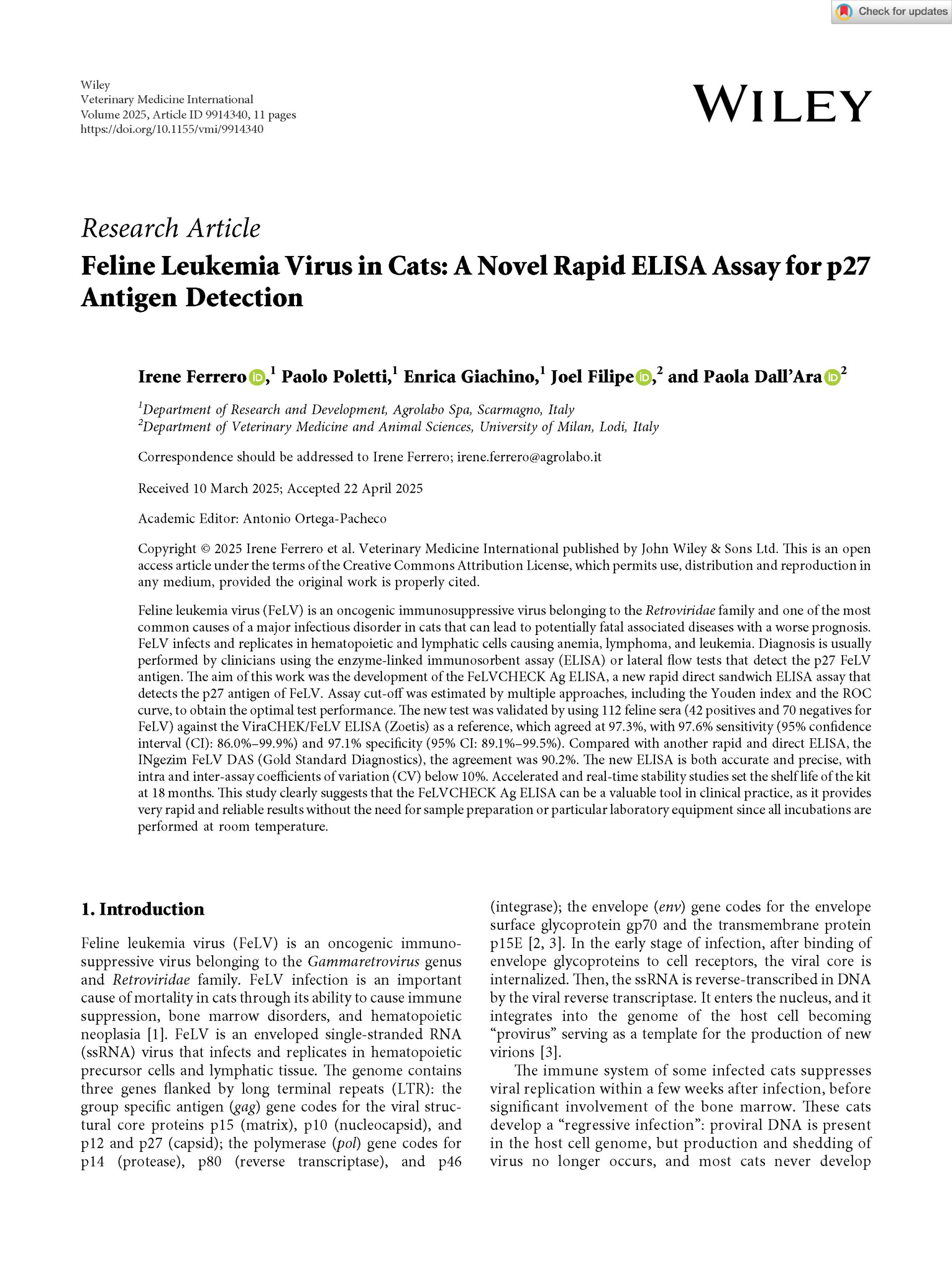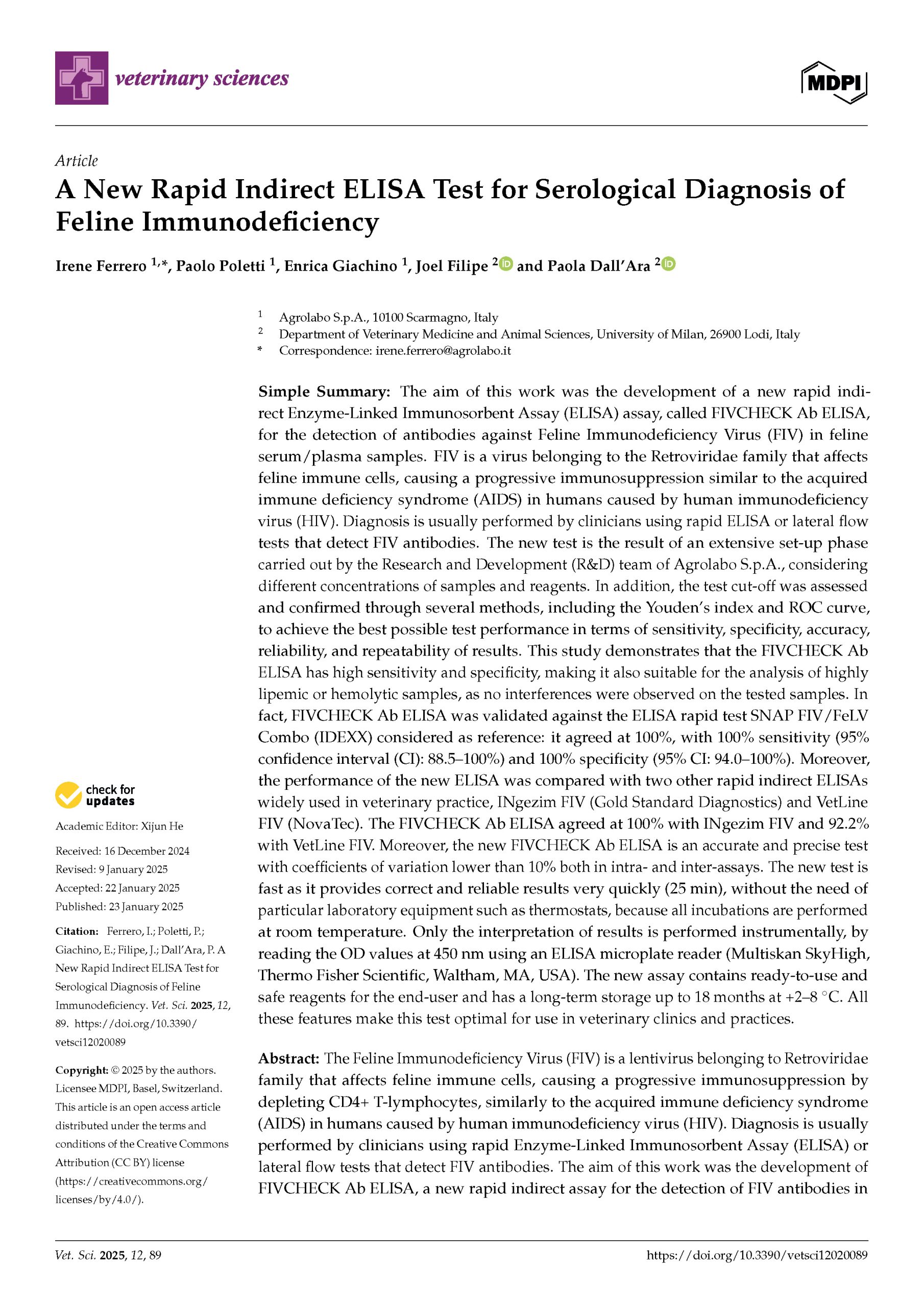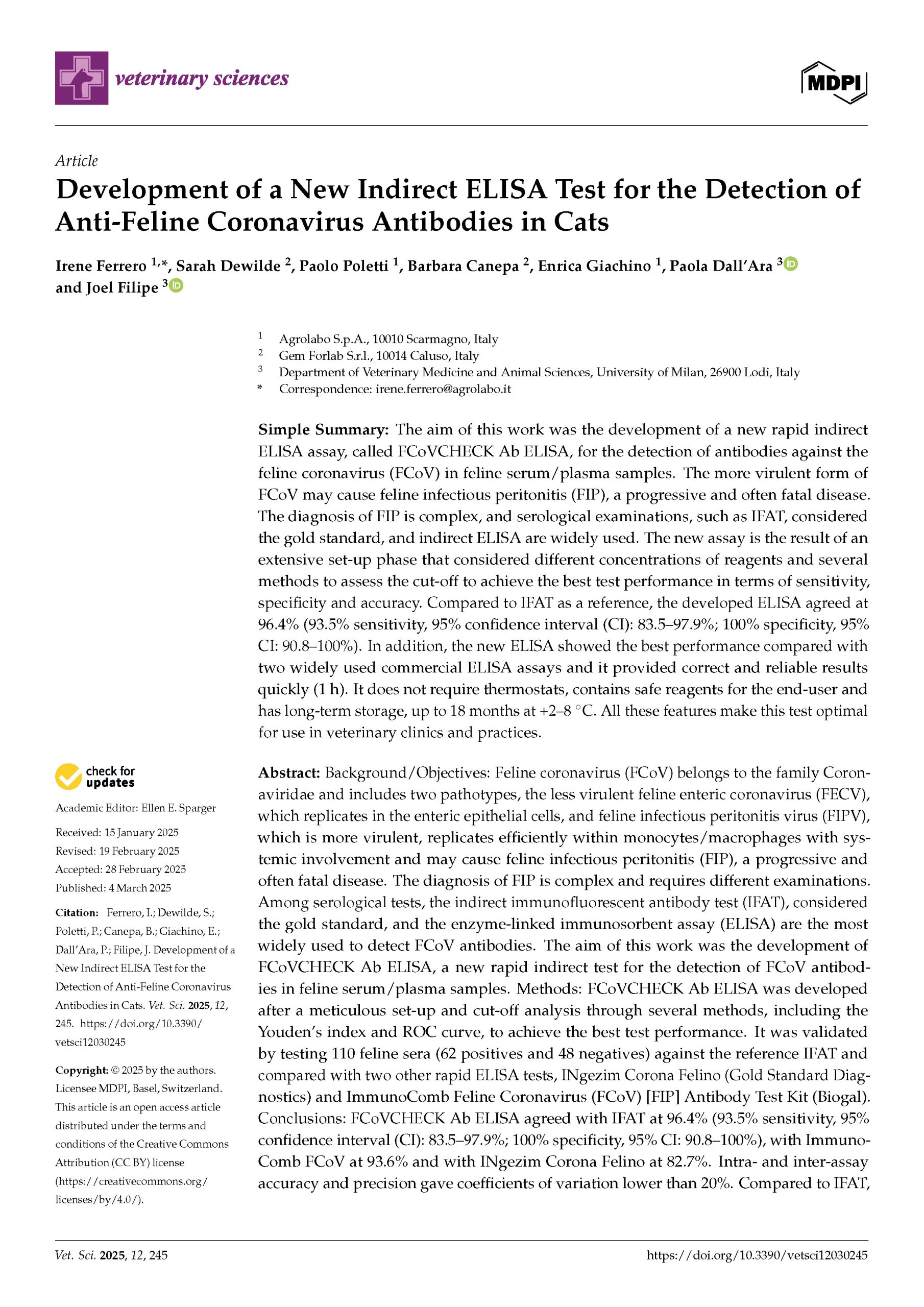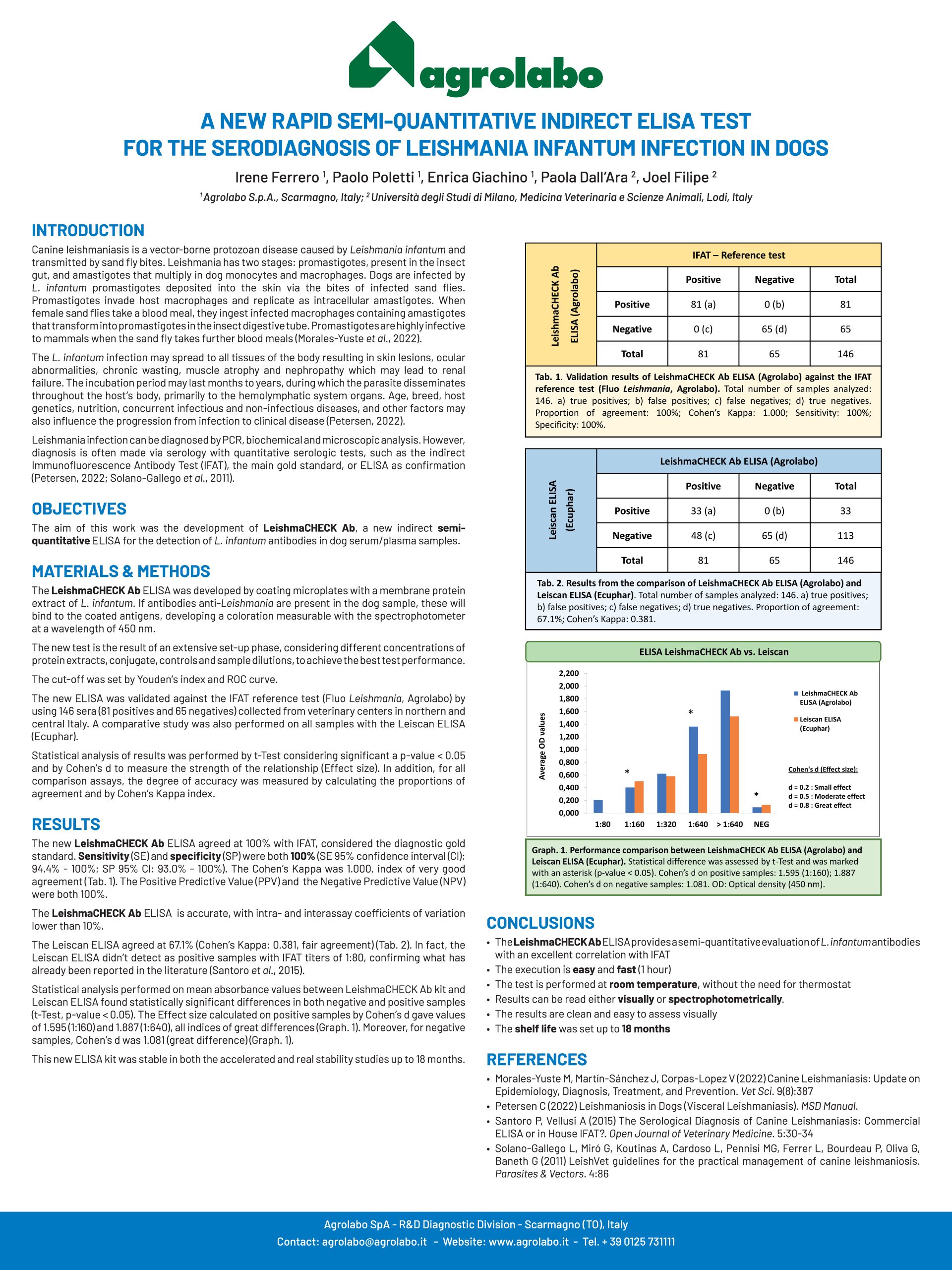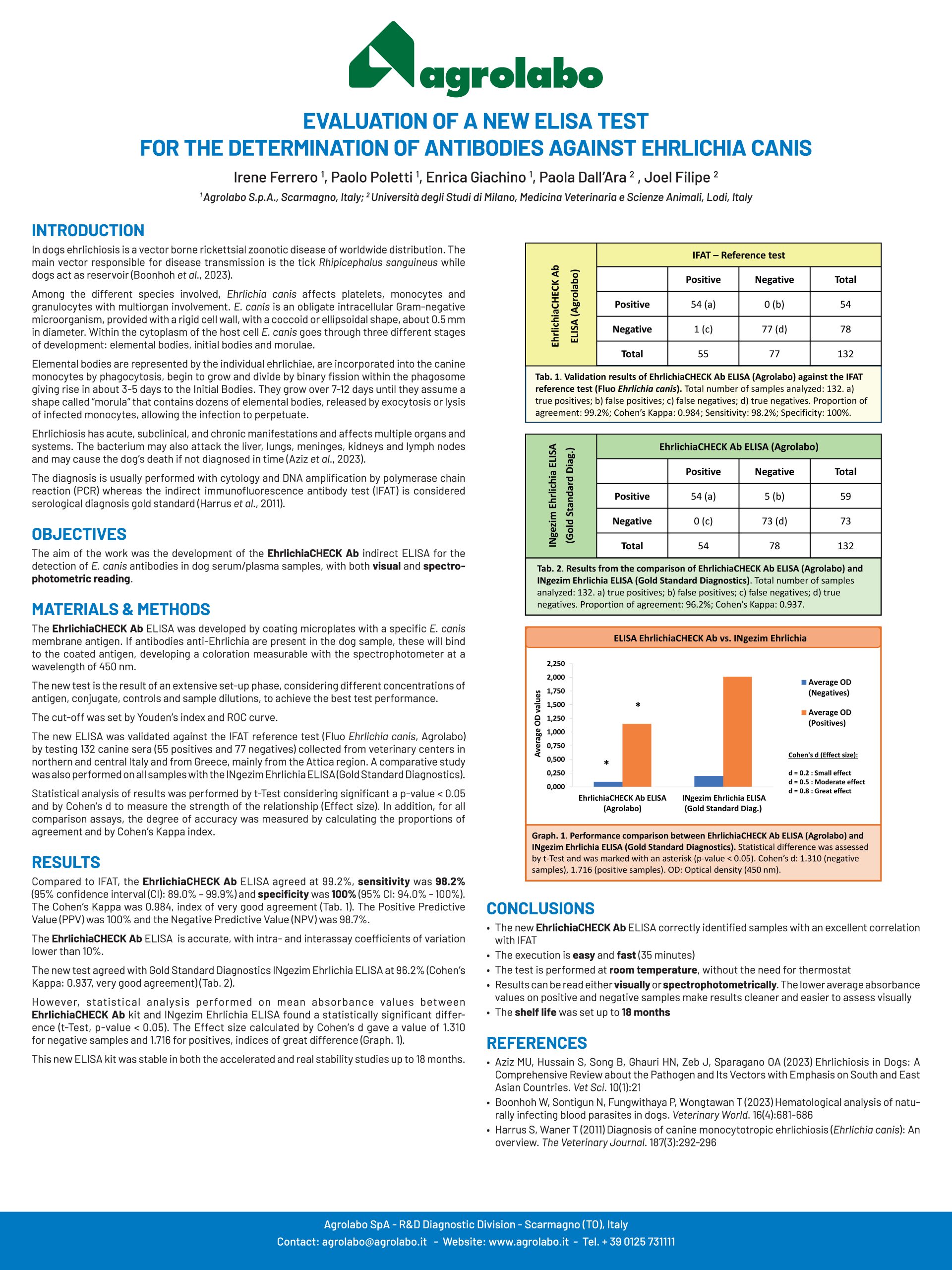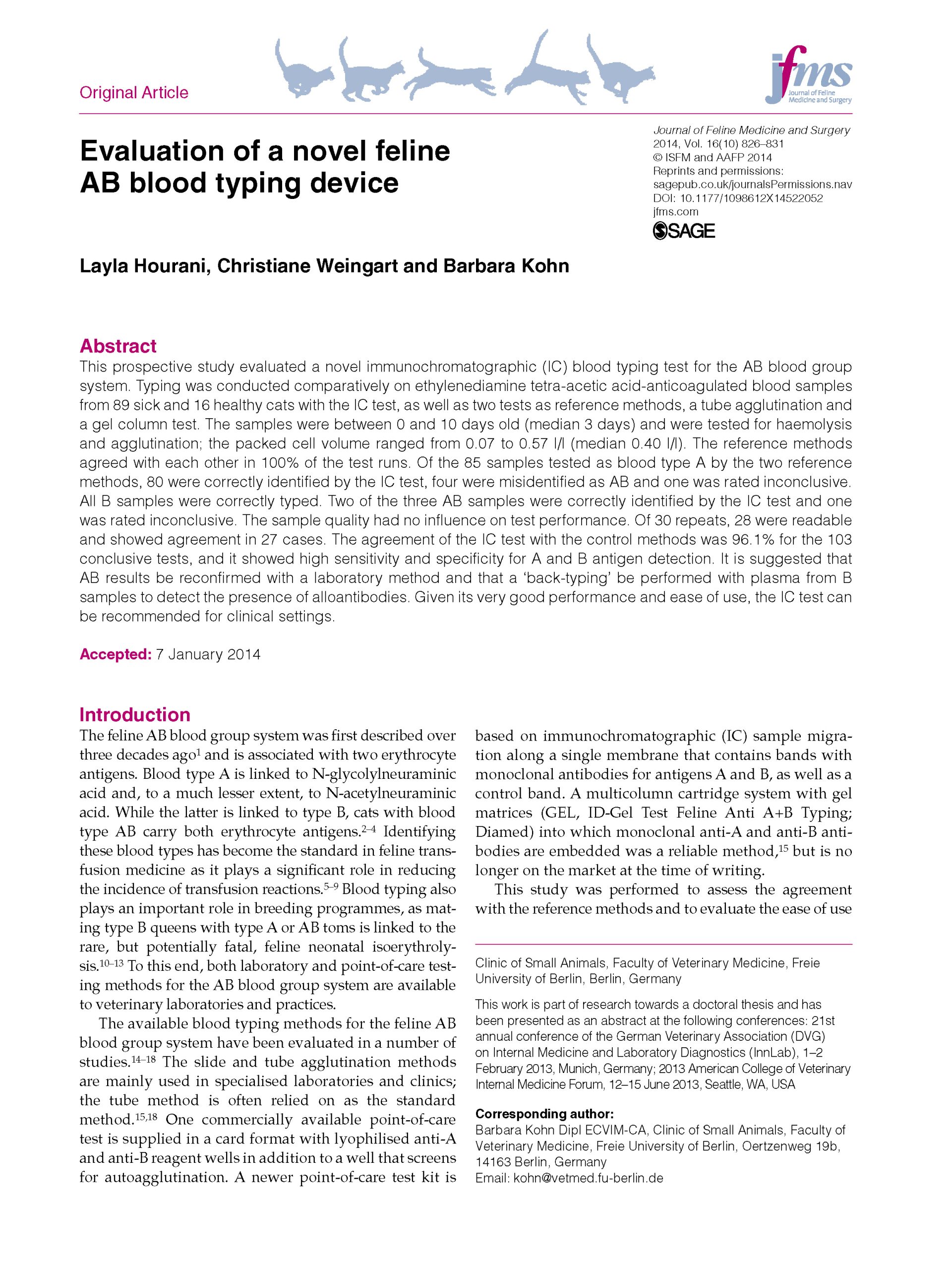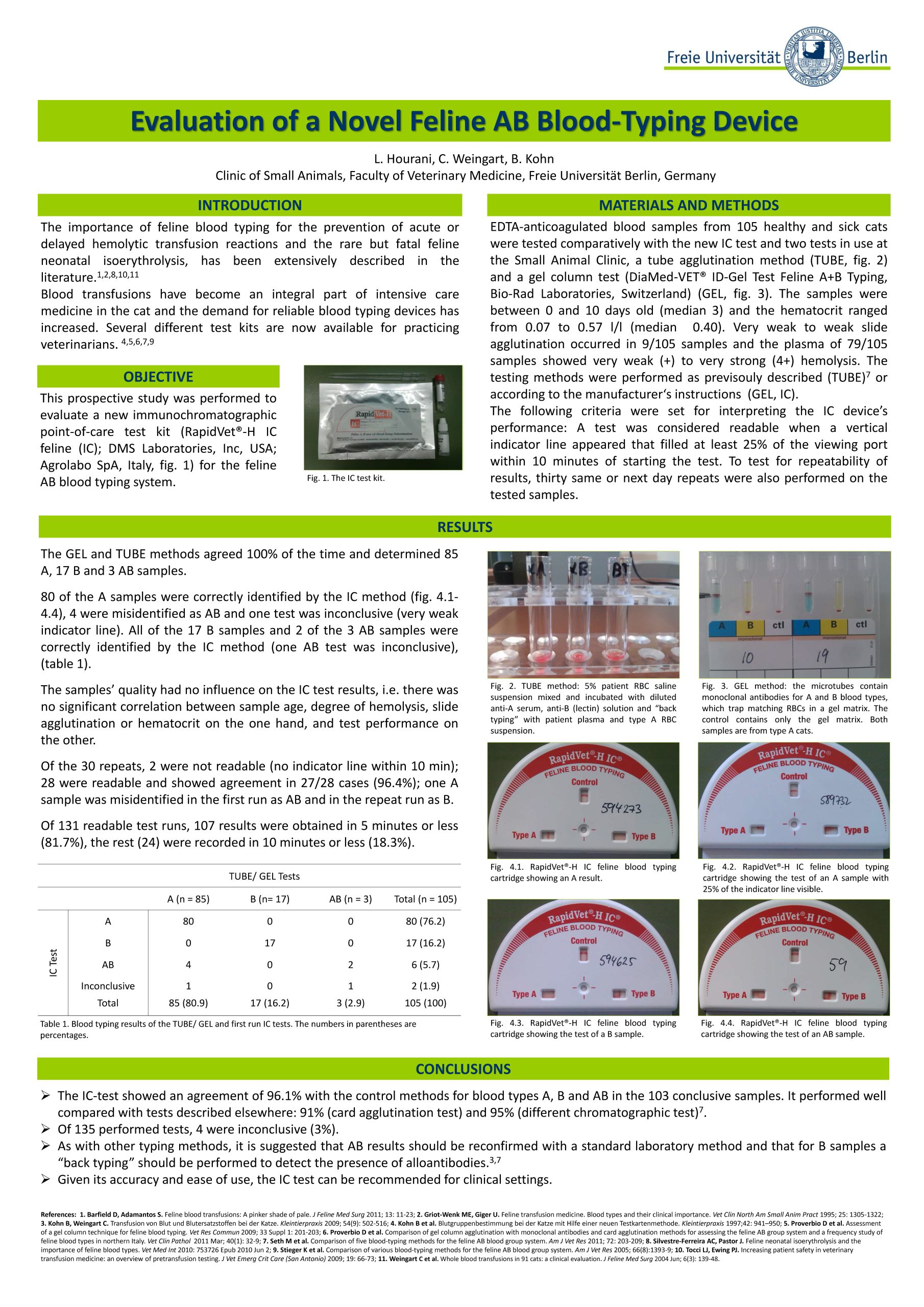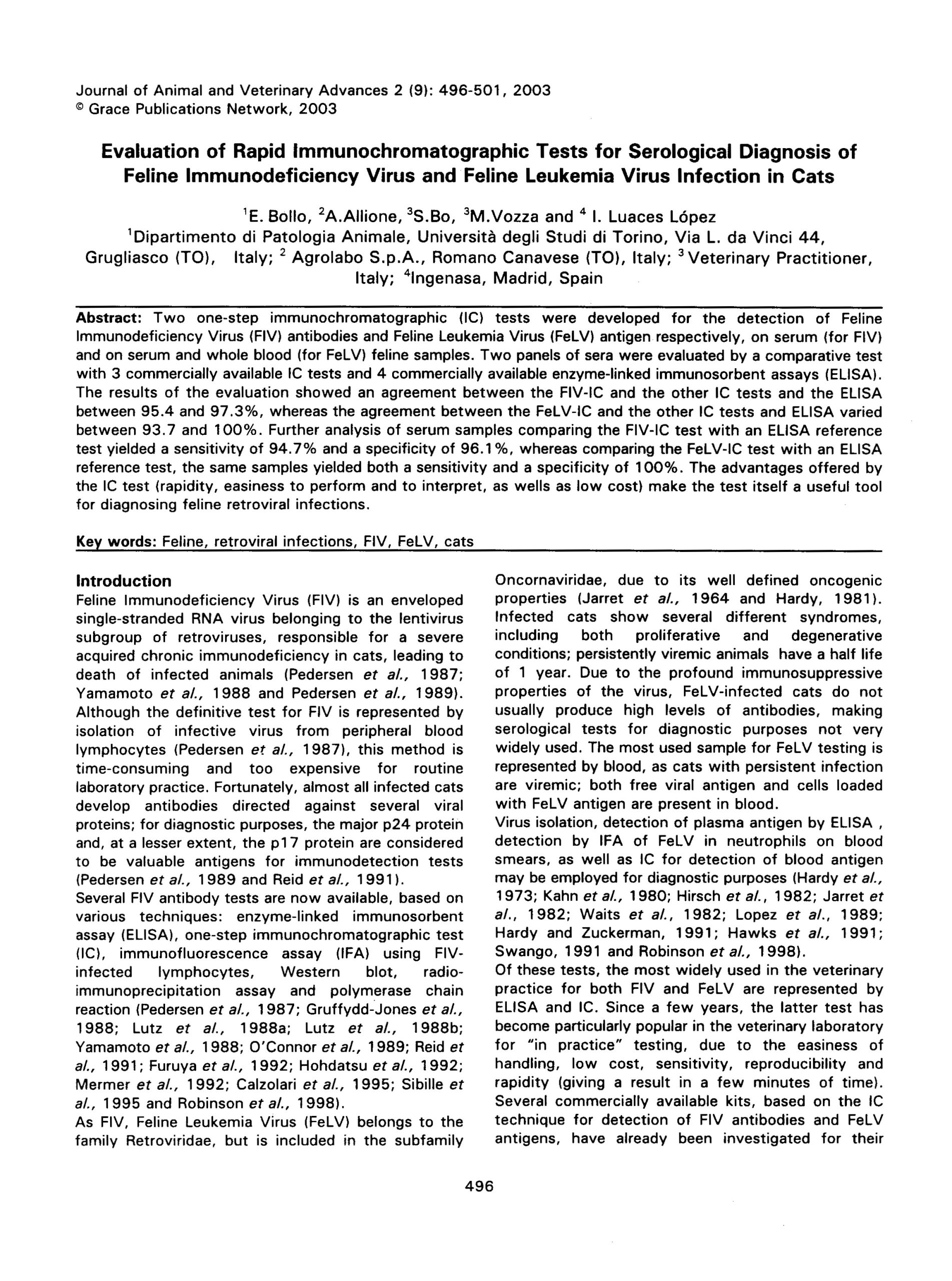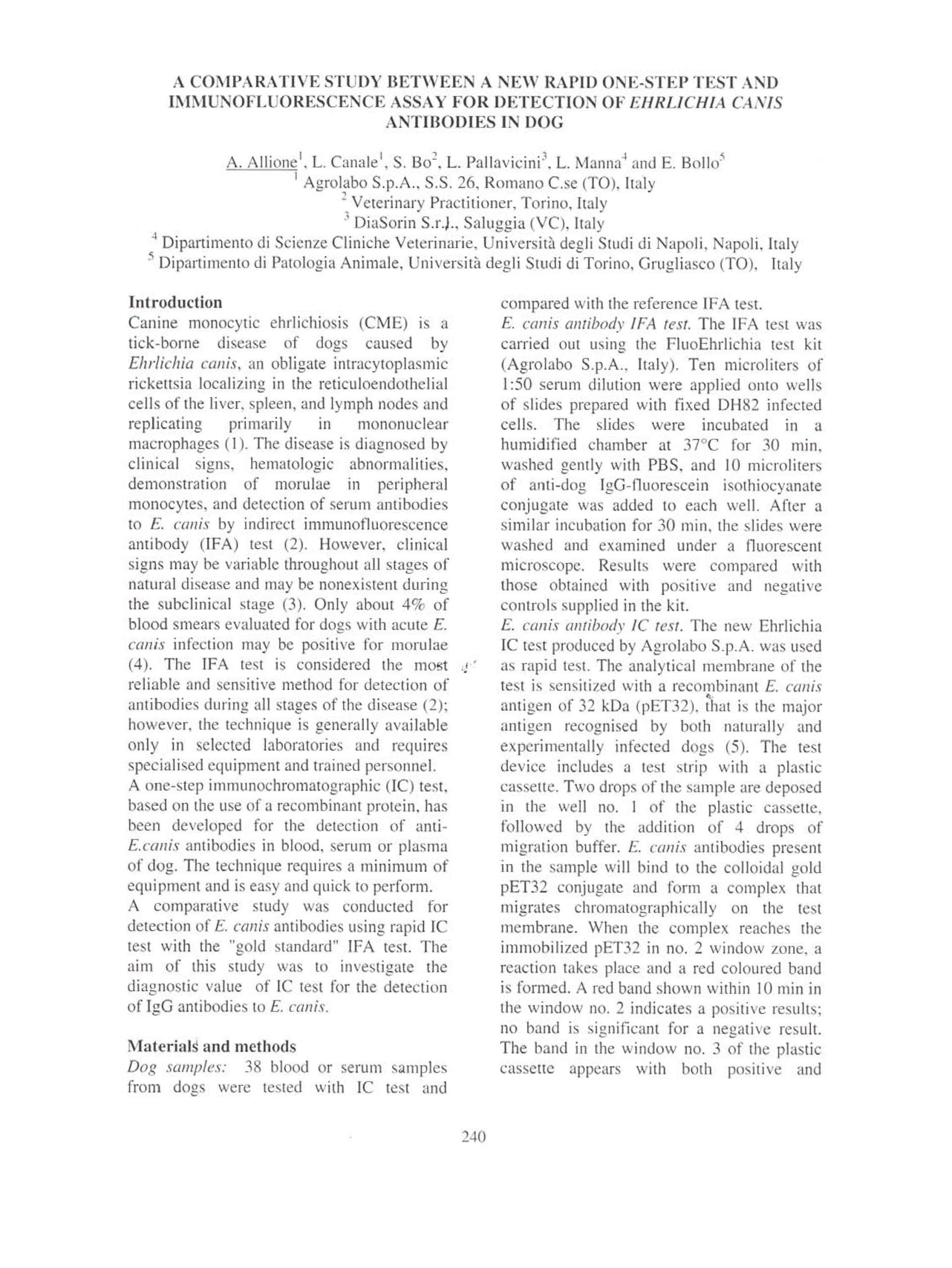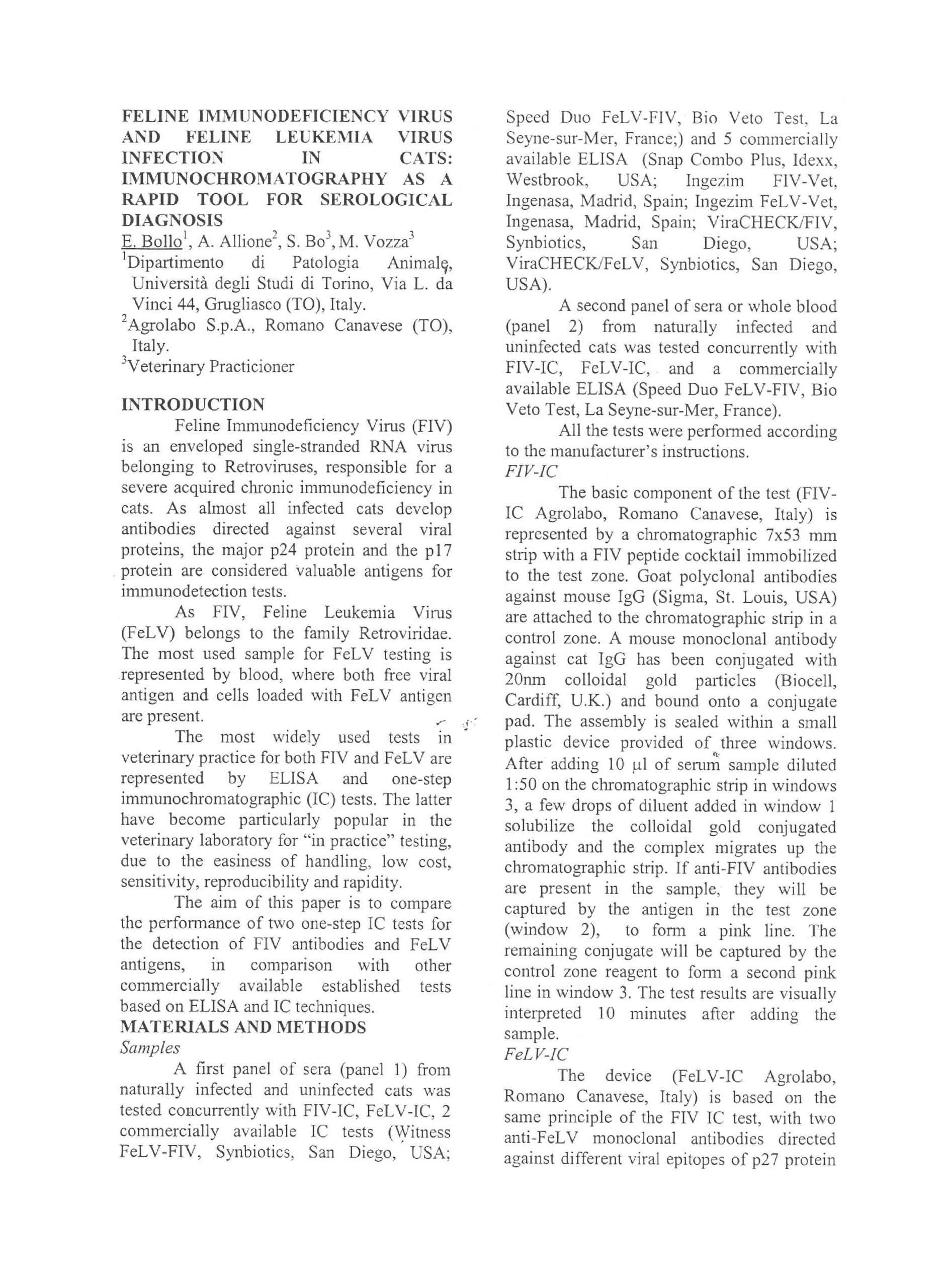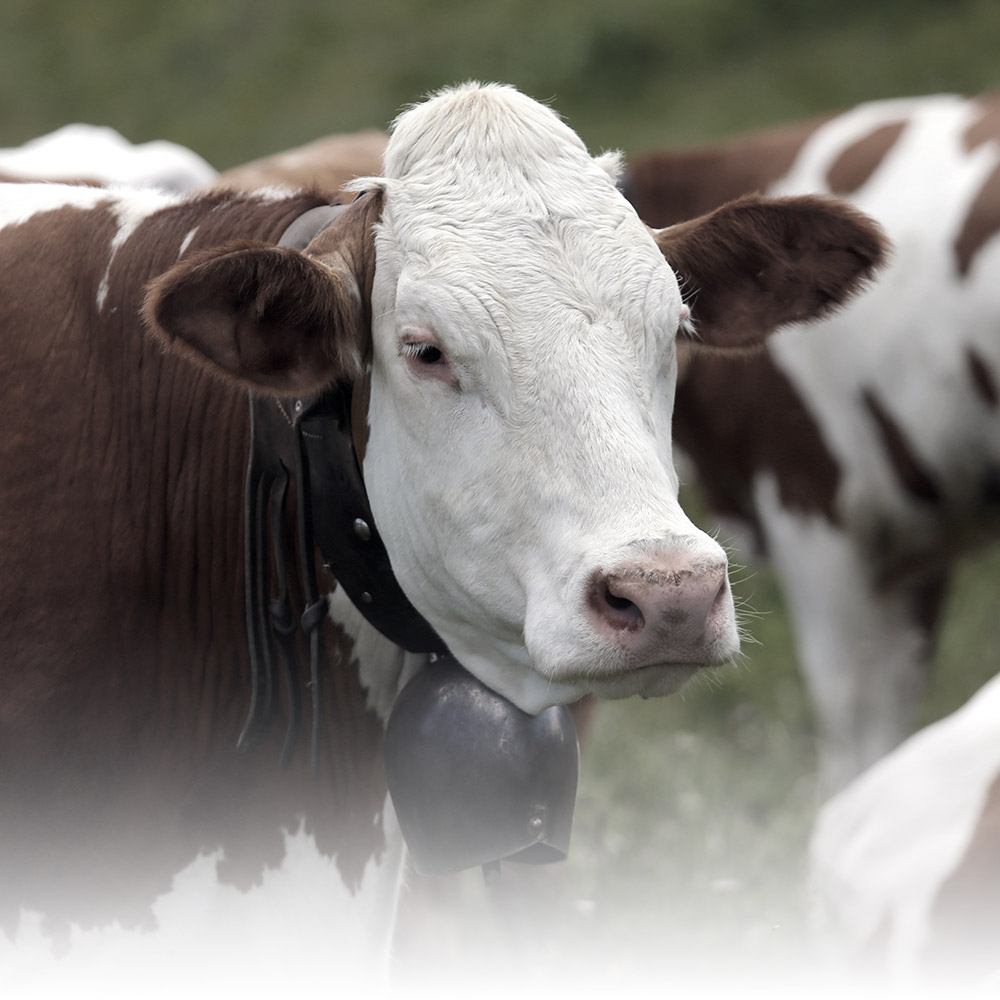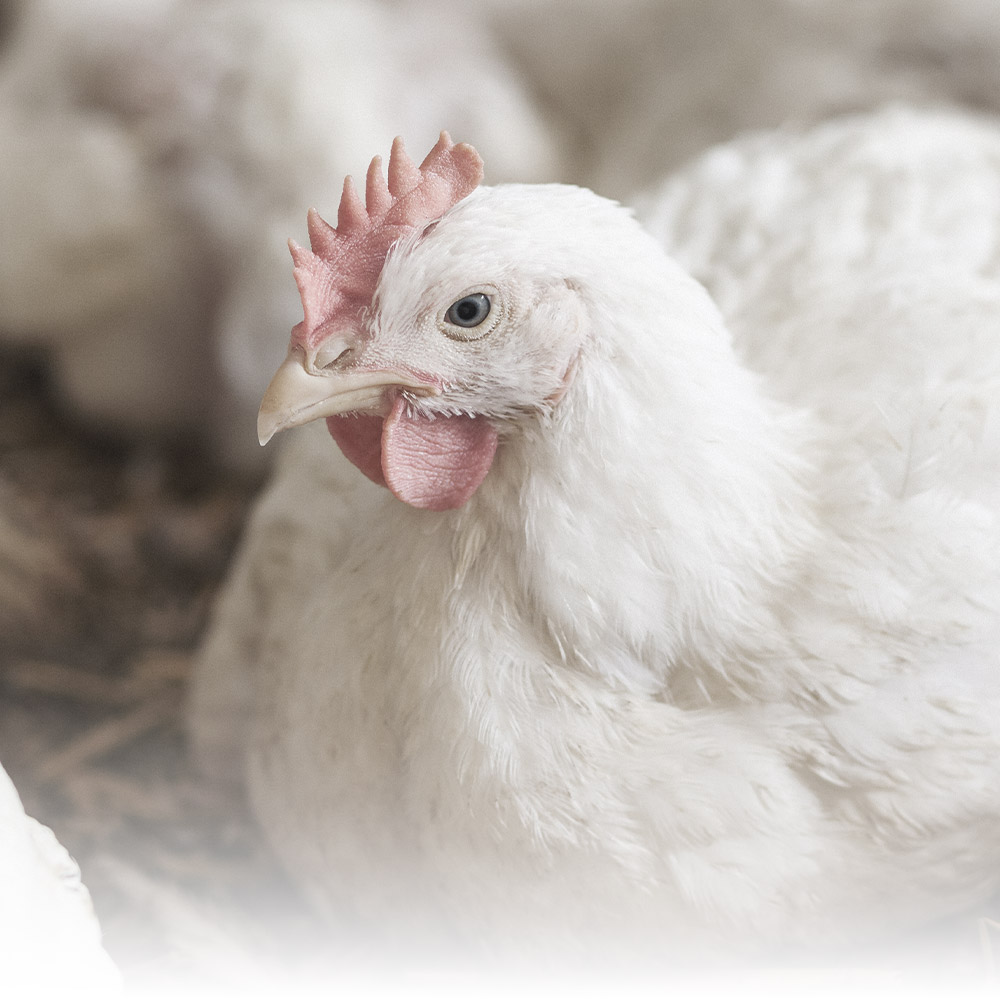DIAGNOSTIC TEST DOCUMENTATION
Validation studies, citations, and use of products for clinical trials
Wiley
Veterinary Medicine International
Volume 2025, Article ID 9914340, 11 pages
https://doi.org/10.1155/vmi/9914340
Research Article
Feline Leukemia Virus in Cats: A Novel Rapid ELISA Assay for p27 Antigen Detection
Irene Ferrero1, Paolo Poletti1, Enrica Giachino1, Joel Filipe2 e Paola Dall'Ara2
1Dipartimento di Ricerca e Sviluppo, Agrolabo Spa, Scarmagno, Italia
2Dipartimento di Medicina Veterinaria e Scienze Animali, Università degli Studi di Milano, Lodi, Italia
Summary
Feline leukemia virus (FeLV) is an oncogenic immunosuppressive virus belonging to the Retroviridae family and one of the most common causes of a major infectious disorder in cats that can lead to potentially fatal associated diseases with a worse prognosis. FeLV infects and replicates in hematopoietic and lymphatic cells causing anemia, lymphoma, and leukemia. Diagnosis is usually performed by clinicians using the enzyme-linked immunosorbent assay (ELISA) or lateral flow tests that detect the p27 FeLV antigen. The aim of this work was the development of the FeLVCHECK Ag ELISA, a new rapid direct sandwich ELISA assay that detects the p27 antigen of FeLV. Assay cut-o; was estimated by multiple approaches, including the Youden index and the ROC curve, to obtain the optimal test performance. The new test was validated by using 112 feline sera (42 positives and 70 negatives for FeLV) against the ViraCHEK/FeLV ELISA (Zoetis) as a reference, which agreed at 97.3%, with 97.6% sensitivity (95% confidence interval (CI): 86.0%–99.9%) and 97.1% specificity (95% CI: 89.1%–99.5%). Compared with another rapid and direct ELISA, the INgezim FeLV DAS (Gold Standard Diagnostics), the agreement was 90.2%. The new ELISA is both accurate and precise, with intra and inter-assay coefficients of variation (CV) below 10%. Accelerated and real-time stability studies set the shelf life of the kit at 18 months. This study clearly suggests that the FeLVCHECK Ag ELISA can be a valuable tool in clinical practice, as it provides very rapid and reliable results without the need for sample preparation or particular laboratory equipment since all incubations are performed at room temperature.
Veterinary Sciences
Vet. Sci. 2025, 12,89.
https://doi.org/10.3390/vetsci12020089
Article
A New Rapid Indirect ELISA Test for Serological Diagnosis of Feline Immunodeficiency
Irene Ferrero1, Paolo Poletti1, Enrica Giachino1, Joel Filipe2 e Paola Dall'Ara2
1Dipartimento di Ricerca e Sviluppo, Agrolabo Spa, Scarmagno, Italia
2Dipartimento di Medicina Veterinaria e Scienze Animali, Università degli Studi di Milano, Lodi, Italia
Abstract
The Feline Immunodeficiency Virus (FIV) is a lentivirus belonging to Retroviridae family that affects feline immune cells, causing a progressive immunosuppression by depleting CD4+ T-lymphocytes, similarly to the acquired immune deficiency syndrome (AIDS) in humans caused by human immunodeficiency virus (HIV). Diagnosis is usually performed by clinicians using rapid Enzyme-Linked Immunosorbent Assay (ELISA) or lateral flow tests that detect FIV antibodies. The aim of this work was the development of FIVCHECK Ab ELISA, a new rapid indirect assay for the detection of FIV antibodies in feline serum/plasma samples; FIVCHECK Ab ELISA was developed after a meticulous setup and cut-off analysis through several methods, including the Youden's index and ROC curve, to achieve the best test performance. The new kit was validated by testing 115 feline sera (38 positives and 77 negatives for FIV antibodies) against the ELISA rapid test SNAP FIV/FeLV Combo (IDEXX). Moreover, 103 sera (28 positives and 75 negatives) were also analyzed with two other rapid indirect ELISAss, INgezim FIV (Gold Standard Diagnostics) and VetLine FIV (NovaTec); FIVCHECK Ab ELISA agreed at 100% with SNAP (100% sensitivity, 95% confidence interval (CI): 88.5–100%; 100% specificity, 95% CI: 94.0–100%), 100% with INgezim FIV and 92.2% with VetLine FIV. Intra- and inter-assay accuracy and precision gave coefficients of variation lower than 10%. The new ELISA is a simple and quick test that provides reliable results for veterinary clinics and practices.
Veterinary Sciences
Vet. Sci. 2025, 12, 245.
https://doi.org/10.3390/vetsci12030245
Article
Development of a New Indirect ELISA Test for the Detection of Anti-Feline Coronavirus Antibodies in Cats
Irene Ferrero1, Sarah Dewilde2, Paolo Poletti1, Barbara Canepa2, Enrica Giachino1, Paola Dall'Ara3, and Joel Filipe3
1 Agrolabo S.p.A., 10010 Scarmagno, Italy
2 Gem Forlab S.r.l., 10014 Caluso, Italy
3 Department of Veterinary Medicine and Animal Sciences, University of Milan, 26900 Lodi, Italy
Abstract
The aim of this work was the development of a new rapid indirect ELISA assay, called FCoVCHECK Ab ELISA, for the detection of antibodies against the feline coronavirus (FCoV) in feline serum/plasma samples. The more virulent form of FCoV may cause feline infectious peritonitis (FIP), a progressive and often fatal disease. The diagnosis of FIP is complex, and serological examinations, such as IFAT, considered the gold standard, and indirect ELISA are widely used. The new assay is the result of an extensive set-up phase that considered different concentrations of reagents and several methods to assess the cut-off to achieve the best test performance in terms of sensitivity, specificity and accuracy. Compared to IFAT as a reference, the developed ELISA agreed at 96.4% (93.5% sensitivity, 95% confidence interval (CI): 83.5–97.9%; 100% specificity, 95% CI: 90.8–100%). In addition, the new ELISA showed the best performance compared with two widely used commercial ELISA assays and it provided correct and reliable results quickly (1 h). It does not require thermostats, contains safe reagents for the end-user and has long-term storage, up to 18 months at +2–8 ◦C. All these features make this test optimal for use in veterinary clinics and practices.
48° WSAVA CONGRESS 2023
27-29 September Lisbon, Portugal
Poster
Development of the LeishmaCHECK Ab ELISA for the detection of L. infantum antibodies in dog serum/plasma samples
IRENE FERRERO 1, PAOLO POLETTI 1, ENRICA GIACHINO 1, PAOLA DALL'ARA 2, JOEL FILIPE 2
1 Agrolabo S.p.A., Scarmagno, Italy;
2 Dip. Medicina Veterinaria e Scienze Animali, Università degli Studi di Milano, Italy
Summary
The aim of this work was the development of LeishmaCHECK Ab, a new indirect qualitative ELISA assay for the detection of L. infantum antibodies in dog serum/plasma samples. Compared to IFAT, LeishmaCHECK Ab agreed at 100%, with 100% sensitivity (95% confidence interval (CI): 94.4% – 100%) and 100% specificity (95% CI: 93.0% – 100%). Intra- and inter-assay accuracy gave coefficients of variation lower than 10%. This new test agreed with Leiscan at 67.12%. The new ELISA test LeishmaCHECK Ab provides a semi-quantitative evaluation of L. infantum antibodies with an excellent correlation with IFAT. In conclusion, the control of leishmaniasis is complex, however LeishmaCHECK Ab ELISA may be a great choice as a rapid and reliable diagnostic method, practical, easy to execute, accurate and suitable for the screening. The test is performed at room temperature, no thermostat is needed. The interpretation of results is fast (1 hour) and it is performed instrumentally by reading the OD values at 450 nm using an ELISA microplate reader.
48° WSAVA CONGRESS 2023
27-29 September Lisbon, Portugal
Poster
EVALUATION OF A NEW ELISA TEST FOR THE DETERMINATION OF ANTIBODIES AGAINST EHRLICHIA CANIS
IRENE FERRERO 1, PAOLO POLETTI 1, ENRICA GIACHINO 1, PAOLA DALL'ARA 2, JOEL FILIPE 2
1 Agrolabo S.p.A., Scarmagno, Italy;
2 Dip. Medicina Veterinaria e Scienze Animali, Università degli Studi di Milano, Italy
Summary
The aim of this work was the development of a new rapid indirect ELISA test for the qualitative detection of anti-Ehrlichia antibodies in dog serum/plasma samples. The new ELISA test EhrlichiaCHECK Ab correctly identifies positive and negative samples with an excellent correlation with IFAT in a quick and easy way, with both visual and spectrophotometric reading. The EhrlichiaCHECK Ab ELISA is performed at room temperature and no thermostat or particular laboratory equipment is needed, only the interpretation of results requires an ELISA microplate reader. The new test is rapid (35 minutes), easy to execute, sensitive, specific, accurate and could be an important aid in confirming the exposure to E. canis where more sophisticated techniques such as IFAT, Western blotting, PCR and tissue culture are not commonly available.
Veterinaria
Anno 31, n°5, Ottobre 2017, Pag. 269-276
https://www.researchgate.net/publication/320978757
Article
Evaluation of an immunochromatographic technique for AB system feline blood typing
Eva Spada1, Roberta Perego2, Luciana Baggiani3, Daniela Proverbio4,
1 University Researcher, Specialist in Companion Animal Pathology and Clinical Practice
2 University Researcher
3 Specialized Laboratory Technician
4 Associate Professor
Department of Veterinary Medicine (DIMEVET), Veterinary Blood Transfusion Medicine Research Laboratory (REVLab), University of Milan, Milan
Abstract
Introduction and aim of the study – Administration of compatible blood is a prerequisite to prevent fatal transfusion reactions in cats. The purpose of this study was to evaluate the performance of a rapid immunochromatographic test for feline blood typing comparing the results with the gold standard technique of tube agglutination.
Materials and methods – Fifty blood samples in EDTA were blood typed in duplicate by tube agglutination and by an immunochromatographic technique. Immunochromatography was also used to type hemodiluted and hemoconcentrated samples, samples anticoagulated with CPDA anticoagulant, and stored at room temperature, at either -20°C or 4-6°C.
Results – The tube technique recorded 36 samples as type A, 9 type B and 5 type AB. Results were identical with the two methods in 45/50 samples with good concordance. Sensitivity and specificity of the immunocromatographic technique were respectively 97.2% and 71.4% for type A, 100% and 100% for type B, 20% and 97.7% respectively for type AB. Concordance was good for type A, excellent for type B and poor for type AB. Immunochromatography was able to correctly type hemodiluted and hemoconcentrated samples, samples anticoagulated with CPDA, and samples stored at room temperature for up to 7 days and at 4-6 ° C for up to 4 weeks.
Discussion – Immunochromatography is able to identify, with high sensitivity and specificity, both type A and type B blood groups, which are the most problematic in transfusion medicine. Using immunochromatography cats with the rare AB group are generally mistakenly typed as group A.
Journal of Feline Medicine and Surgery
2014, Vol. 16(10) 826–831
https://pubmed.ncbi.nlm.nih.gov/24518253/
Articolo
Evaluation of a novel feline AB blood typing device
Layla Hourani, Christiane Weingart and Barbara Kohn
Clinic of Small Animals, Faculty of Veterinary Medicine, Freie
University of Berlin, Berlin, Germany
This work is part of research towards a doctoral thesis and has been presented as an abstract at the following conferences: 21st annual conference of the German Veterinary Association (DVG) on Internal Medicine and Laboratory Diagnostics (InnLab), 1–2 February 2013, Munich, Germany; 2013 American College of Veterinary Internal Medicine Forum, 12–15 June 2013, Seattle, WA, USA.
Abstract
This prospective study evaluated a novel immunochromatographic (IC) blood typing test for the AB blood group system. Typing was conducted comparatively on ethylenediamine tetra-acetic acid-anticoagulated blood samples from 89 sick and 16 healthy cats with the IC test, as well as two tests as reference methods, a tube agglutination and a gel column test. The samples were between 0 and 10 days old (median 3 days) and were tested for haemolysis and agglutination; the packed cell volume ranged from 0.07 to 0.57 l/l (median 0.40 l/l). The reference methods agreed with each other in 100% of the test runs. Of the 85 samples tested as blood type A by the two reference methods, 80 were correctly identified by the IC test, four were misidentified as AB and one was rated inconclusive.
All B samples were correctly typed. Two of the three AB samples were correctly identified by the IC test and one was rated inconclusive. The sample quality had no influence on test performance. Of 30 repeats, 28 were readable and showed agreement in 27 cases. The agreement of the IC test with the control methods was 96.1% for the 103 conclusive tests, and it showed high sensitivity and specificity for A and B antigen detection. It is suggested that AB results be reconfirmed with a laboratory method and that a 'back-typing' be performed with plasma from B samples to detect the presence of alloantibodies. Given its very good performance and ease of use, the IC test can be recommended for clinical settings.
EHRLICHIA IC – UK 2001
World Association of Veterinary Laboratory Diagnosticians
X International Symposium of Veterinary Laboratory Diagnosticians and OIE Seminar on Biotechnology
Salsomaggiore – Parma, Italy
4-7 July 2001
By Società Italiana di Diagnostica Veterinaria
Article
A comparative study btween a new rapid one-step test and immunofluorescence assay for detection of Ehrlichia canis antibodies in dog
A.Allione1, L.Canale1, S.Bo1, L.Pallavicini3, L.Manna4, E.Bollo5
1 Agrolabo S.p.A, S.S. 26. Romano C.se (TO), [taly
2 Veterinary Practitioner, Torino, Italy
3 DiaSorin S.r.L., Saluggia (VC), ltaly
4 Dipartimento di Scienze Cliniche Veterinarie, Università degli Studi di Napoli, Napoli, ltaly
5 Dipartimento di Patologia Animale, Università degli Studi di Torino, Grugliasco (TO), Italy
Abstract
The results or this study demonstrate that caine serum IgG antibodies to Ehrlichia canis can be measured wilhout any laboratory equipment using an ICtest kit . The ELISA OD and the IFA titers were closely correlated to IC results. Sensitivity and specificity values of IC test were respectively of 90.4% and 100%, but sensitivity could be higher analysing a larger number of samples. The agreement between IC and both IFA test and ELISA is 94,7%. revealing good positive and negative predictive values. Several advantages of IC tests against other commonly used diagnostic tests (i.e. ELISA and IFA) can be highlighted: the one step test procedure is quick and easy to perform, does not require skilled laboratory personnel and sample preparation, the test kit may be stored at room temperature for a long time (up to 15 months), the visual interpretation is easy and no dedicated equipment is needed. Finally, the short time required to obtain a result and the low cost of the test are also important factors for the veterinarian and the dog owner.
World Association of Veterinary Laboratory Diagnosticians
X International Symposium of Veterinary Laboratory Diagnosticians and OIE Seminar on Biotechnology
Salsomaggiore – Parma, Italy
4-7 July 2001
By Società Italiana di Diagnostica Veterinaria
Article
A comparative study between a new rapid one-step test and immunofluorescence assay for detection of Ehrlichia canis antibodies in dog
A.Allione1, L.Canale1, S.Bo1, L.Pallavicini3, L.Manna4, E.Bollo5
1 Agrolabo S.p.A, S.S. 26. Romano C.se (TO), [taly
2 Veterinary Practitioner, Torino, Italy
3 DiaSorin S.r.L., Saluggia (VC), ltaly
4 Dipartimento di Scienze Cliniche Veterinarie, Università degli Studi di Napoli, Napoli, ltaly
5 Dipartimento di Patologia Animale, Università degli Studi di Torino, Grugliasco (TO), Italy
Abstract
The results or this study demonstrate that caine serum IgG antibodies to Ehrlichia canis can be measured wilhout any laboratory equipment using an IC test kit . The ELISA OD and the IFA titers were closely correlated to IC results. Sensitivity and specificity values of IC test were respectively of 90.4% and 100%, but sensitivity could be higher analysing a larger number of samples. The agreement between IC and both IFA test and ELISA is 94,7%. revealing good positive and negative predictive values. Several advantages of IC tests against other commonly used diagnostic tests (i.e. ELISA and IFA) can be highlighted: the one step test procedure is quick and easy to perform, does not require skilled laboratory personnel and sample preparation, the test kit may be stored at room temperature for a long time (up to 15 months), the visual interpretation is easy and no dedicated equipment is needed. Finally, the short time required to obtain a result and the low cost of the test are also important factors for the veterinarian and the dog owner.
World Association of Veterinary Laboratory Diagnosticians
X International Symposium of Veterinary Laboratory Diagnosticians and OIE Seminar on Biotechnology
Salsomaggiore – Parma, Italy
4-7 July 2001
By Società Italiana di Diagnostica Veterinaria
Article
Feline Immunodeficiency Virus and Feline Leukemia Virus and Feline Leukemia Virus Infection in Cats: Immunochromatography as a Rapid Tool for Serological Diagnosis
Bollo1, A.Allione2, S.Bo3, M.Vozza3
1 Dipartimento di Patologia Animale, Università degli Studi di Torino, Via L. da Vinci 44, Grugliasco (TO), Italy;
2 Agrolabo S.p.A., Romano Canavese (TO), Italy;
3 Veterinary Practitioner, Italy;
Summary
The results of the evaluation showed agreements betwecn 95,4% and 97,3% for FIV and between 93,7% and 100% for FeLV. By comparing the results obtained with serum samples in the FIV-IC test and the ELISA reference test, the sensitivity and specificity were lower (94,7% and 96,1%, respectively), while the sensitivity and specificity of serum samples obtained comparing the FeLV-IC test with the ELISA reference test were both 100%. The difference in reactivity of the FIV-IC test under evaluation observed with the sera panel may be the consequence of a different conformation of the peptides in the cocktail used as capture antigen, or an earlier production of antibodies to gp40 than antibodies to p24. Several advantagcs of IC tests against other commonly used diagnostic tests (i.e. ELISA) can be highlighted: the one step test procedure is quick and easy to perform, does not require skilled laboratory personnel and sample preparation, the test kit may be slored at room temperature for a long lime (up to 15 months), the visual interpretation is easy to be performed and no dedicated equipment is needed. Finally, the short time required to obtain a result and the low cost of the test are also important factors for the veterinarian and the cat owner.
